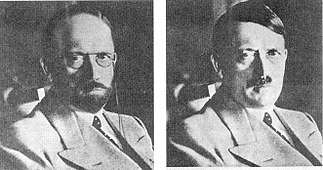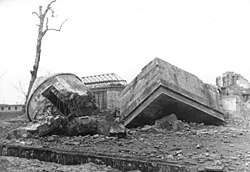Conspiracy theories about Adolf Hitler's death

Conspiracy theories about Adolf Hitler's death contradict the fact that he committed suicide in the Führerbunker on 30 April 1945. Most of these theories hold that Hitler and his wife, Eva Braun, survived and escaped from Berlin, Germany, and Europe. While these theories have received some exposure in popular culture, such as in the book Grey Wolf: The Escape of Adolf Hitler, these viewpoints are regarded by historians and scientific experts as disproven fringe theories.[1]
Origins

The theory that Hitler did not commit suicide, but instead escaped with his wife, was promoted by the Soviet government as part of its state-sponsored disinformation campaign.[2][3] The myth was first presented to the public by Marshall Georgy Zhukov at a press conference on 9 June 1945, on orders from Soviet leader Joseph Stalin.[4] When asked at the Potsdam Conference in July 1945 how Hitler had died, Stalin said he was living "in Spain or Argentina."[5] This has been a springboard for various conspiracy theories, despite the official conclusion by Western powers, and the consensus of historians, that Hitler killed himself on 30 April 1945.[6][7][8]
The first detailed investigation by Western powers began in November 1945 after Dick White, then head of counter-intelligence in the British sector of Berlin, had their agent Hugh Trevor-Roper investigate the matter to counter the Soviet claims. His findings that Hitler and Braun had died by suicide in Berlin were written in a report in 1946 and published in a book the next year.[9] Regarding the case, Trevor-Roper reflected, "the desire to invent legends and fairy tales ... is (greater) than the love of truth".[10] In 1947, 51 percent of Americans polled thought Hitler was still alive.[11]
Evidence
Declassified FBI documents contain a number of alleged sightings of Hitler along with theories of his escape from Germany. The FBI states that the information within those documents pertaining to the escape and sightings of Hitler cannot be verified.[12]
On 30 May 1946, while the Soviets were investigating rumours of Hitler's survival,[13] two fragments of a skull were retrieved from the crater where Hitler was buried. The left piece of the parietal bones had gunshot damage.[14] It was kept in Russia's federal archives in Moscow, and believed to be Hitler's for decades. In 2009, samples of the skull were DNA-tested at the University of Connecticut by a bone-specializing archaeologist. The sample was found to be that of a woman aged under 40.[13]
However, neither former Soviet nor Russian officials have claimed the skull was the main piece of evidence, instead citing jawbone fragments and two dental bridges found in May 1945. The items were shown to Hitler's dentist Hugo Blaschke, his assistant Käthe Heusermann, and longtime dental technician Fritz Echtmann, who confirmed the dental remains were Hitler's and Braun's.[15][16] In 2017, Philippe Charlier, a French forensic pathologist, confirmed that teeth on one of the jawbone fragments were in "perfect agreement" with an X-ray taken of Hitler in 1944.[17]
Alleged escape to Argentina
Grey Wolf: The Escape of Adolf Hitler, by British authors Simon Dunstan and Gerrard Williams, suggests that Hitler and Braun did not commit suicide, but actually escaped to Argentina. The scenario proposed by the two authors is as follows: a number of U-boats took certain Nazis and Nazi loot to Argentina, where the Nazis were supported by future president Juan Perón, who, with his wife "Evita", had been receiving money from the Nazis for some time. Hitler allegedly arrived in Argentina, first staying at Hacienda San Ramón, east of San Carlos de Bariloche.[18][12] Hitler then moved to a Bavarian-styled mansion at Inalco, a remote and barely accessible spot at the northwest end of Lake Nahuel Huapi, close to the Chilean border. Around 1954, Eva Braun left Hitler and moved to Neuquén with their daughter, Ursula ("Uschi"); and Hitler died in February 1962.[19]
This theory of Hitler's flight to Argentina has been dismissed by historians, including Guy Walters. He has described Dunstan and Williams' theory as "rubbish", adding: "There's no substance to it at all. It appeals to the deluded fantasies of conspiracy theorists".[20] Walters contends that "it is simply impossible to believe that so many people could keep such a grand scale deception so quiet,"[18] and says that no serious historian would give the story any credence.[18] In 2014, Grey Wolf, a controversial docudrama film based on the book by Dnnstan and Williams, was produced by Williams. It ended with an extensive list of people who claimed to have seen Hitler in Argentina.
Investigators of the History Channel series Hunting Hitler claim to have found previously classified documents and to have interviewed witnesses indicating that Hitler escaped from Germany and traveled to South America by U-boat.[21] He and other Nazis then allegedly plotted a "Fourth Reich".
A declassified CIA document dated 3 October 1955 highlights claims made by a "former German SS trooper" named Phillip Citroen that Hitler was still alive, and that he "left Colombia for Argentina around January 1955." Enclosed with the document was an alleged photo of Citroen and who was claimed to be Hitler; on the back of the photo was written "Adolf Schrïttelmayor" and the year 1954. The report also states that neither the contact who reported his conversations with Citroen, nor the CIA station was "in a position to give an intelligent evaluation of the information".[22]
See also
References
Notes
- ↑ Lusher, Adam (20 May 2018). "Adolf Hitler really is dead: scientific study debunks conspiracy theories that he escaped to South America". The Independent. Retrieved 11 September 2018.
- ↑ Eberle & Uhl 2005, p. 288.
- ↑ Kershaw 2001, p. 1037.
- ↑ Joachimsthaler 1999, pp. 22, 23.
- ↑ Beschloss 2002.
- ↑ Joachimsthaler 1999, pp. 160–182.
- ↑ Kershaw 2008, p. 955.
- ↑ Stern, Marlow (16 November 2015). "Hitler's Final Days Revealed: Eyewitnesses Recount the Nazi's Death in Unearthed Footage". The Daily Beast.
- ↑ MI5 staff (2011). "Hitler's last days". Her Majesty's Security Service website. Retrieved 24 March 2016.
- ↑ Joachimsthaler 1999, p. 28.
- ↑ Le Faucher, Christelle (May 21, 2018). "Hitler Dead or Alive". WWII Museum. Retrieved 16 September 2018.
- 1 2 "FBI — Adolf Hitler Part 01 of 04 - File No 105-410". vault.fbi.gov. Retrieved 3 September 2014.
- 1 2 Osborn, Andrew (28 September 2009). "Adolf Hitler suicide story questioned after tests reveal skull is a woman's". The Telegraph.
- ↑ Eberle & Uhl 2005, pp. 287, 288.
- ↑ Kershaw 2008, p. 958.
- ↑ Eberle & Uhl 2005, p. 282.
- ↑ Brisard & Parshina 2018, pp. 224, 273–274.
- 1 2 3 Walters, Guy (28 October 2013). "Did Hitler flee bunker with Eva to Argentina, have two daughters and live to 73? The bizarre theory that's landed two British authors in a bitter war". Daily Mail. London. Retrieved 28 May 2014.
- ↑ Dunstan, Simon and Williams, Gerrard. (2011) Grey Wolf: The Escape of Adolf Hitler. New York: Sterling Publishing. ISBN 9781402781391
- ↑ Dewsbury, Rick; Hall, Allan; Harding, Elanor (18 October 2011). "Did Hitler and Eva Braun flee Berlin and die (divorced) of old age in Argentina?". Daily Mail. London. Retrieved 28 May 2014.
- ↑ Anderson, John (10 November 2015). "One Industry That Capitalizes On America's Hitler Fascination". Fortune. Retrieved 11 September 2018.
- ↑ "#HVCA-2592" (PDF). CIA.gov. Retrieved 5 September 2018.
Bibliography
- Beschloss, Michael (December 2002). "Dividing the Spoils". Smithsonian Magazine. Retrieved 14 September 2018.
- Brisard, Jean-Christophe; Parshina, Lana (2018). The Death of Hitler. Da Capo Press. ISBN 978-0306922589.
- Eberle, Henrik; Uhl, Matthias, eds. (2005). The Hitler Book: The Secret Dossier Prepared for Stalin from the Interrogations of Hitler's Personal Aides. New York: Public Affairs. ISBN 978-1-58648-366-1.
- Joachimsthaler, Anton (1999) [1995]. The Last Days of Hitler: The Legends, The Evidence, The Truth. London: Brockhampton Press. ISBN 978-1-86019-902-8.
- Kershaw, Ian (2001) [2000]. Hitler, 1936–1945: Nemesis. 2. London: Penguin. ISBN 978-0-14-027239-0.
- Kershaw, Ian (2008). Hitler: A Biography. New York: W. W. Norton & Company. ISBN 978-0-393-06757-6.
Further reading
- Petrova, Ada and Watson, Peter (1995) The Death of Hitler: The Full Story with New Evidence from Secret Russian Archives. New York: W. W. Norton & Company. ISBN 978-0-393-03914-6
- Trevor-Roper, Hugh (1995) [1947] The Last Days of Hitler. London: Pan Books. ISBN 978-1-4472-1861-6
- Vinogradov, V. K.; Pogonyi, J.F.; Teptzov, N.V. (2005). Hitler's Death: Russia's Last Great Secret from the Files of the KGB. London: Chaucer Press. ISBN 978-1-904449-13-3.